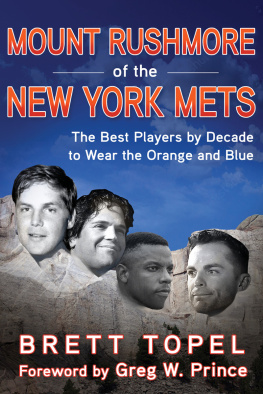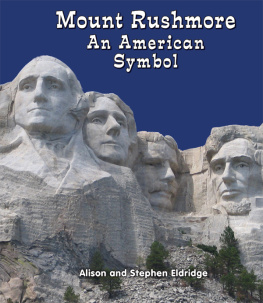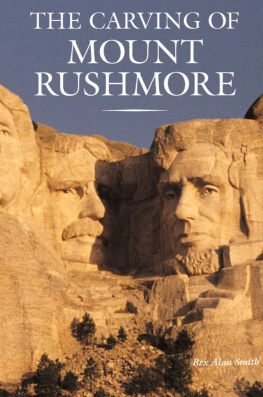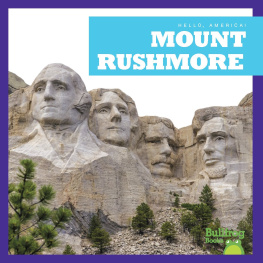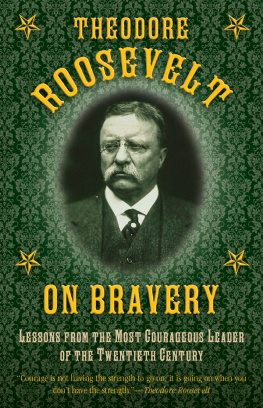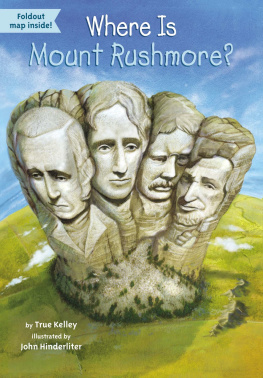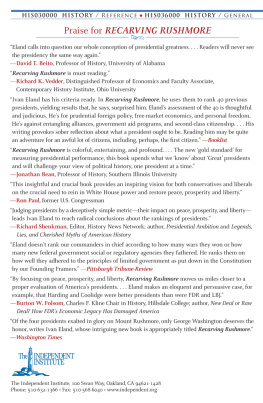


Copyright 2021 by Brett Topel
Foreword copyright 2021 by Greg W. Prince
All rights reserved. No part of this book may be reproduced in any manner without the express written consent of the publisher, except in the case of brief excerpts in critical reviews or articles. All inquiries should be addressed to Sports Publishing, 307 West 36th Street, 11th Floor, New York, NY 10018.
Sports Publishing books may be purchased in bulk at special discounts for sales promotion, corporate gifts, fund-raising, or educational purposes. Special editions can also be created to specifications. For details, contact the Special Sales Department, Sports Publishing, 307 West 36th Street, 11th Floor, New York, NY 10018 or .
Sports Publishing is a registered trademark of Skyhorse Publishing, Inc., a Delaware corporation.
Visit our website at www.sportspubbooks.com.
10 9 8 7 6 5 4 3 2 1
Library of Congress Cataloging-in-Publication Data is available on file.
Cover design by Kai Texel
Cover photographs by Getty Images
Print ISBN: 978-1-68358-417-9
Ebook ISBN: 978-1-68358-418-6
Printed in the United States of America
Other New York Mets books by Brett Topel
When Shea Was Home: The Story of the 1975 Mets, Yankees, Giants, and Jets
So You Think Youre a New York Mets Fan?: Stars, Stats, Records, and Memories for True Diehards
Miracle Moments in New York Mets History: The Turning Points, the Memorable Games, the Incredible Records
To Oliver and Lily
Contents
Foreword:
Heres to You, Mrs. Payson
M ore than a generation after Id last seen her, I learned my favorite teacher had recently passed away. Her name was Mrs. Cuneo. She taught English to ninth graders and taught this ninth grader who liked to write to think of himself as a writer. When I received the sad phone call telling me of her passing, I learned one more thing: Mrs. Cuneo had a first name. I suppose she always did, but I never needed to know it. She was Mrs. Cuneo in junior high and she is Mrs. Cuneo to me forever more.
I invoke the warm and wonderful Mrs. Cuneo here as a conduit to recall the warm and wonderful Mrs. Payson. Mrs. Paysons first name I knew. It was right there in the New York Mets 1972 official yearbook, atop the DIRECTORS & OFFICIALS page. Mrs. Joan W. Payson (President), she was captioned in the first Mets yearbook to grace what Bob Murphy termed my baseball library. Hers was the only one among the nine executive headshots whose image was presented with an honorific, the only one whose honorific wouldnt have been Mr.and the only person pictured who wore a stylish hat.
Mrs. Payson had another title the yearbook didnt mention. She was the owner of the team. It would be brought up now and then in the papers or during broadcasts. Mrs. Payson, owner of the Mets... Nobody seemed to refer to her as just Payson, which would have been too cold and, in the gender norms of the day, considered discourteous. Nobody seemed to call her just Joan, which likely would have sounded too familiar. As a kid absorbing all the Mets information I could, it was enough to know that my team was in the hands of Mrs. Payson, the nice lady with the hat. Besides, Mrs. Payson didnt buy a ballclub to grab attention for herself. When she agreed to take the title of president, she secured a promise from her fellow directors and officials: they couldnt make her make any speeches.
It didnt much occur to me in my elementary school years, when I was serving the de facto apprenticeship that led to my lifelong Mets fandom, to wonder how Mrs. Payson came to own my favorite baseball team or, really, how exactly my favorite baseball team came to be. There was something said around the time I received that yearbook, however, that clued me in a bit. The Mets had traded for Willie Mays which, even at the age of nine, knocked me off my proverbial feet. Willie Mays had been the greatest player in baseball for a long time, going back to his debut with the then New York Giants in 1951. What was he suddenly doing one fine May day switching uniforms, taking off the one that said Giants and slipping on the one that said Mets?
Well, the story went, Mrs. Payson wanted him among us. As Mays biographer James Hirsch put it, she loved horses, fine paintings, and miniature antique furniture. And she loved Willie Mays. Mrs. Payson was the owner of the Mets because she used to own a small stake in the Giants when they and Mays were based in New York. I was brought up on the Giants, she explained. Mrs. Payson provided the seed money for the franchise that became known as the Mets because there were no longer any Giants nearby for her to cheer. National League fans like herwhether they loved the Giants or were partial to the Dodgershad been left high, dry, and lonely. Most New Yorkers deprived of their senior circuit sweethearts after 1957 could only mope and ignore the Yankees. Mrs. Payson could fund an entirely new New York National League baseball team.
Thats what the nice lady with the hat did. Mrs. Payson had the means. She was wealthy, and what was the point of being a big fan with resources if she couldnt fill a gaping hole in the heart of summertime? In 1962, that meant bankrolling this lovable if losing-prone expansion outfit called the Metropolitans. In 1972, that meant bringing Mays home when he finally became available toward the end of his brilliant career. For fourteen seasons as club owner, Mrs. Payson wanted to make us happy. Lest it be seen as solely an act of selfless generosity, she also wanted to have a ballclub to experience alongside us.
She maintained the best seats in the house, a first-base box at Shea adjacent to the Mets dugout. Its hard to imagine anyone would begrudge the native New Yorker her view or proximity. When she attended games, she kept score. When she traveled, she kept up. As befitting a true fan, she had her sensible superstitions and her understandable excesses. In the first season there were Mets, as she visited Europe, she asked to be telegraphed results whenever the Mets played. Deluged by bad baseball news from home, she amended the request so that she be contacted only when the Mets won. Telegrams thus ceased being sent. In 1969, when pennant-race excitement transcended whatever Western Union could deliver, she paid a reported $10,000 to a local TV station so they would pick up and air for her enjoyment a couple of handfuls of Mets games from Channel 9 down in New York while she vacationed in Maine. You might say that in addition to founding the Mets, Mrs. Payson invented on-demand viewing.
Mostly the lady who inherited a fortune and put it to Amazin use kept clear of the spotlight. Had she lived a little longer, it would have been fascinating to see Mrs. Payson embrace free agency, a revolution she missed by a couple of offseasons. As it was, she tried to purchase Willie Mayss contract when the Mets were fresh and Mays was in his prime, inquiring of her old business partner Horace Stoneham if he might accept, say, a million dollars for the center fielders services. A million dollars was real money circa 1962.
The Giants werent about to say yes. But a decade later, Stoneham needed whatever cash he could get in San Franciscoand wanted Willie in a locale where he could be properly compensated, not to mention lavished with love. For far less than a million bucks (plus minor-league pitcher Charlie Williams), he sent his superstar to Shea Stadium, by then as close as one could spiritually get to the Polo Grounds. Mays was forty-one in 72, but Mrs. Payson had finally gotten the Mets her man. Sentimental New Yorkers everywhere reached for their handkerchiefs.
Next page
